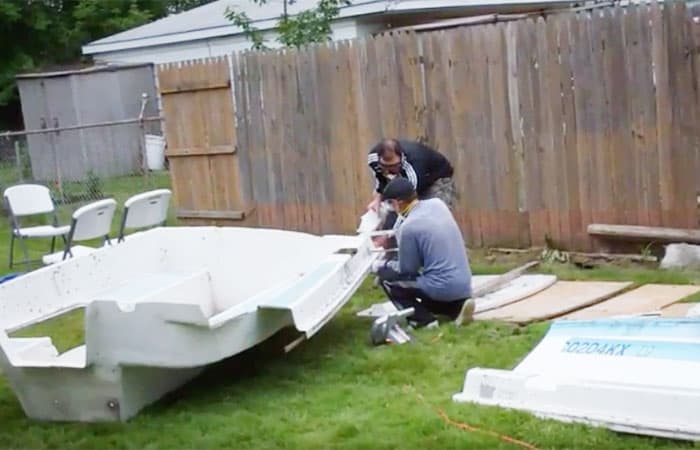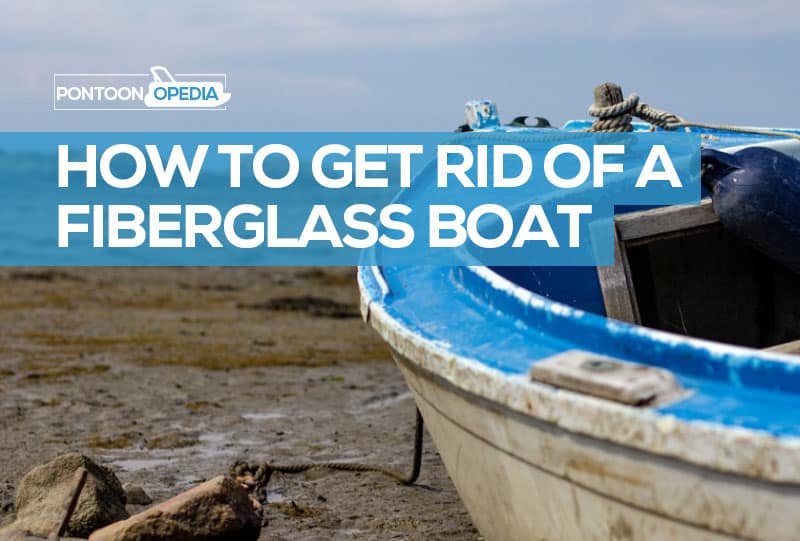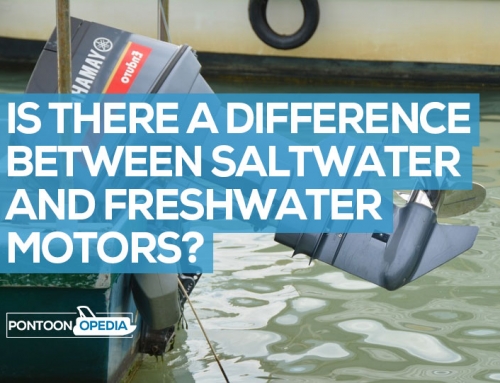There comes a time in every boat’s life cycle where the constant repairs simply become too expensive, or it could be that you have a new boat and need to clear up some space.
You might think that you can just tow it down to the local rubbish heap and dispose of it there. However, in today’s environmentally friendly landscape it is important to dispose of materials that can cause harm to the environment in the correct and legal way.
In some areas you can and will be fined for improperly disposing of your boat. If you can’t simply sell it then this article will discuss all the options available to you if you want to know how to get rid of a junk fiberglass boat.
Below I will go into detail on how best to get rid of your old fiberglass boat, this will include all the steps from donating it to simply getting your hands dirty and recycling it yourself.
1. Donate to a charity
Even though you may think that you cannot save your boat from the clutches of the deep, others may still have the time and energy to repair it and derive some benefit from it.

You might find a local disabled boating charity who could make use of your old boat.
There are various charities that specialise in the repurposing of old boats; ask at your local marina for some charities that you could possibly donate to – it could help local disabled people get into boating for the first time.
There are also various VTIP (vessel turn in programs) that allow you to arrange for a drop off point for your vessel and members of the organisation will collect the boat free of charge. You can see an example of a VTIP program in the State of Washington.
Donating your boat to a charity or school can also provide tax benefits.
If your boat is truly a hunk of junk, then there is a good chance no charity will want it. If that’s the case keep reading.
2. Sink your boat (don’t do this)
The short answer here is to never intentionally sink your boat!

Sinking might seem like a good option at the time, but it’s selfish!
You might get told by some that intentionally sinking or scuttling your old junk fiberglass boat is great way to get rid of it. After all out of sight, out of mind, right?
Wrong.
Sinking a boat on purpose can lead to extremely high fines and even jail time depending on where you do it.
This practice is damaging to the marine environment, especially if you have not properly cleaned out the boat and removed all toxic fluids, batteries and other materials that can harm marine life.
Also, if your sunken secret snags a trawlers net then you can bet they will try to track you down and demand compensation.
It might seem like a fun and easy solution, but it definitely won’t be fun when you are presented with a fine.
Sunken boats can also present a risk to other skippers who are not aware that there is something beneath them.
Sinking the junk fiberglass boat won’t create an idyllic reef, bed, or river. There can be so many toxic substances in play that have been used to make and operate your boat so please don’t do it.
So, in short, it’s not worth the effort or the risk and can have a very negative impact on your local environment.
3. Burning fibreglass boats (don’t do this)
There are plenty of website forums and videos on YouTube of people burning fiberglass boats as one way to dispose of them. Again, I don’t recommend this for a number of reasons.

Burning a fiberglass boat is not recommended for various reasons.
Firstly, you need a really high temperature to get the entire boat destroyed. If not, you get left with the fiberglass strands and short fibers that will catch in the wind, causing a huge hazard. You would not want anyone breathe these in.
Secondly, you will end up with a huge pile of fibers left on the ground. Someone will need to clean those up, and if you do it away from your property it’s going to leave a lot of evidence behind, which will also be bad for the environment.
Please don’t burn your fiberglass boat.
4. Abandon your boat (don’t do this)
So, you can’t sink your boat, as exciting as that might be.

Don’t abandon your old fiberglass boat for someone else to get rid of responsibly.
Perhaps you can just leave it under a tree somewhere and go on with your life?
Wrong. This again is a terrible idea and illegal dumping is also a fineable offense.
You wouldn’t **** on your own doorstep, so why ruin the beautiful surroundings by leaving your hunk of junk for other people to clean up?
It could even be traced back to you with the VIN or HIN number… don’t do it.
Did you know? The recovery of abandoned boats has been estimated to represent a big impact on tax spending, with the cost of recovery and disposal coming in at around $450 per foot of boat!
5. Give it away
There are various websites where you can list your boat as free to collect. One person’s junk can be another’s treasure.

That old boat could be given to a new owner and used for a new purpose after you no longer need it.
But, if the boat is in a really bad condition, then please make the prospective new owner aware of the possible challenges of getting rid of it.
Passing on your problem to another unwitting person who thinks they are getting the bargain of a lifetime is quite simply bad karma.
6. Sell it to a salvager or new owner
If you have a decent sized boat, then it might be possible to sell it to a salvager. They will typically come out and assess the salvage value of your boat and if it makes economic sense, they will take it off your hands.

Salvagers might be able to get something of value out of your old fiberglass boat.
However, if it is not of much value then they will not accept it, even for free.
There might even be someone out there looking to buy an old junk fiberglass boat for a refurbishment project. You would be surprised at what people will buy!
Handy Hint: Click here for negotiation tips you can use when selling or buying a used boat.
7. Take it to a landfill site
One option is to simply take it down to your local landfill site, but make sure you first phone ahead before taking the boat. There are usually a lot of rules for dumping and disposing of fiberglass boats, and you may be required to first remove all toxic fluids from the boat before taking it to the landfill.

Taking to a landfill site can be expensive, but might be your only viable disposal option,
They will then proceed to deconstruct the boat with whatever heavy equipment they have on hand – if you have fond memories of your boat you may not want to witness this part!
There will also be a charge for taking the boat and if this is too much you can then move onto the final option below.
8. Recycle your old fiberglass boat
If you have read this far it is likely that you have one of the world’s most unwanted pieces of scrap. At this point you may be so frustrated that you might actually enjoy the process of recycling your boat.

If you decide to cut your boat up, use and wear the correct safety gear.
Please do not handle any cutting equipment unless you are trained in their use and are aware of the unique challenges and safety hazards of cutting and handling fiberglass.
A pinched cutting blade can be extremely dangerous. If you aren’t comfortable using this type of equipment rather enlist the services of someone who is.
How to recycle a fiberglass boat
Recycling your boat can possibly result in some financial gain if you an get all the good metal bits off it and cut up all the worthless fiberglass. You can either recycle your fiberglass boat yourself, or find somewhere else to take it.
Let’s start off with the DIY method.
Step 1 – Drain all fluids
Like any mechanical device, there are lots of toxic fluids required to make it run, these can include fuel, oil hydraulic fluid, and other liquids. You will need to first drain all of this into drums.
Do not mx the fluids into one drum as worst case you will create some exothermic chemical reaction or could get a tongue lashing from the people at the hazardous waste disposal facility.
Always dispose of any hazardous fluids through the official channels.
Don’t be that person that dumps chemicals into water ways and municipal drains; the knock-on effects of your actions contribute to devastating environmental damage.
If your boat is large you may have sewerage tanks on it as well. I don’t recommended you try to clean this yourself, unless you are a sucker for punishment and looking at getting some nasty disease relating to handling sewage!
Step 2 – Remove all equipment and gear
Once all the fluids are removed you can begin by disconnecting your battery from the boat. This is to ensure that you do not get any unwanted shocks while removing any other electrical devices.
Depending on the type of battery you may need to take it to the local recycling centre; do not just throw it in the garbage.
It is also important to note which components are worth salvaging.
If it is an old boat, most of the electrical systems will be obsolete so trying to salvage them will be a waste of time and effort.
Most of the stuff you pull off the boat will be worthless, and you could try selling off individual parts online, but this could be a long drawn out process that will likely be more frustrating that just throwing it away.
You will want to keep all the metal parts aside as taking these to a scrap yard is quick and easy and can sometimes yield a surprising amount of cash.
If you are the hoarding kind you can maybe keep some things you think can be of use in future.
Step 3 – Cut the boat up
This is the most dangerous part of the exercise so be careful and consult an expert if you are unsure on how to do it properly.
Before doing any cutting make sure the boat is very well supported and plan your cuts in such a way as to eliminate any unexpected movement.
Before starting the cuts make sure you have the correct PPE (protective clothing and safety gear). Cutting fiberglass creates a lot of dust and unpleasant fumes when broken up.
Furthermore, this dust can itch for days if it gets on your skin so get a one-piece disposable overall, tight fitting gloves, safety goggles (not safety glasses) and a dust mask or a full-face respirator to keep yourself from harm.
You can now begin cutting; start with the top structure and then remove all the interiors. Finally, you can cut up the hull.
Chances are that at some point you tore your cheap disposable overall and some of that nasty powder got onto your skin so when you’re done with the cutting grab a cold shower to wash off the dust. If you find you are still itching a few days later, take a long soak in the bath.
Step 4 – Dispose of the fiberglass parts
Chances are your home garbage won’t be big enough to carry all that fiberglass so look for a refuse removal company who can drop off an empty skip for you to load all the fiberglass into. They will then come and collect when you are done.
You can also load in whatever you think might not be scrapable.
Where to recycle fiberglass boats near me?
I referenced the vessel turn in programs earlier in this guide. These are the best places where you can recycle a fiberglass a boat near you.
Here is a list of those fiberglass boat recycling options in a few of the major states around the country:
What happens to old fiberglass boats?
As you can see from my guide, there’s no one correct answer, with multiple options. It’s certainly a big problem though, as it has been estimated that around 40 million boats are coming towards the end of their lives.
The issue is that there is no one correct procedure for disposing of them, and no one organisation has taken responsibility to come up a standard disposal or recycling program in the United States.
Most old fiberglass boats are cut up into pieces and then placed into landfill, but this is not a sustainable strategy as you can imagine.
There needs to be an industry-wide initiative developed for the proper disposal and recycling of old fiberglass boats, but as yet, there is nothing planned.






